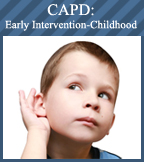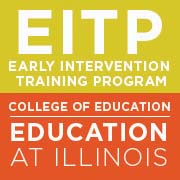Affecting approximately 3%-7% of school-age children and with a 2:1 ratio between boys and girls, CAPD typically presents in early childhood as difficulty with spelling, reading, and understanding information presented verbally in the classroom. Its cause often described as an idiosyncrasy or maturational delay of the central nervous system, CAPD is a lifelong challenge in the ability to learn, process and understand the often dizzying array of incoming sensory data from the outside world, despite normal hearing and intelligence.
Auditory processing disorder (CAPD) is a generic umbrella term that describes a complex spectrum of developmental disorder subtypes whose common denominator involves a diminishment of auditory processing within the brain. The child with CAPD has a normal hearing mechanism and undiminished aural function as peripheral hearing is normal. By way of analogy, auditory processing disorder is to hearing as dyslexia is to seeing. Just as dyslexics can see letters and words, but fail to connect them for reading, those with CAPD can hear, but their brains are not able to process some sounds meaningfully.
While not diagnosed until a child is 3.6 years of age, and then confirmed after age 12 by a uniquely tailored audiologic battery to identify subtype, many children may be treated in the early intervention setting, given positive risk factors, warranting therapy for phonological delays addressing symptoms, not the diagnosis irrespective of the root cause or diagnostic label as prophylaxis, and despite CAPD being unrecognized by the ICDM or DSM as a distinct diagnostic entity.
Age-appropriate phonological development and the successful achievement of language milestones during the pre-linguistic and linguistic periods as a strategy of warding off the likelihood of CAPD in children with multiple risk factors, especially given the neuroplasticity of the young brain. Early detection, intervention and prevention – by way of phonemic awareness and audiological treatment - serves as prophylaxis that precludes a language problem early enough to stave off the effects of a language problems and may promote neural pathways and synapses, neural processes and new circuitry between key brain modules.
- Identify risk factors, clinical presentation, and how each discipline in a multidisciplinary approach uniquely contributes toward the assessment and screening of CAPD
- Understand the difference between ‘hearing’ and ‘listing’ as a function of the auditory cortices (and their ectopias) as well as risk factors, co-morbidities and presentation of CAPD
- Understand how information processing models uniquely differ from the (bottom up cognitive model approach) audiological versus the (top down Gestalt model) speech professional approach, and why both paradigms are essential to successful information processing
- Identify the various subtypes of CAPD and how each is separately and uniquely managed, once identified
- Understand the commonality between hyperacusis &/or distractibility to ambient classroom noise (averaging at 59 decibels) as a function of the reticular activating system, especially with an inability to filter out surrounding noise
- Identify the components of audiological battery behavioral tests or psycho-acoustic tests as well as electrophysiological testing
- Identify the two-standard approaches to management - auditory-skill training that bolsters the child’s temporal processing and listening-in-noise abilities, and phoneme-awareness & phonological training.
- Identify why other professionals can assess for CAPD, but only an audiologist may diagnose the condition
- Discern the basis for disagreement speech and audiologic professionals re: audio-testing – whether verbal or non-verbal sounds are best utilized.
- Identify how to clinically differentiate between CAPD and ADHD and dyslexia
- Provider will be able to: Identify treatment approaches, including environmental modifications, learning environment, compensatory strategies, and (direct) remediation
- Identify why referrals for occupational and physical therapy are often necessary in children with CAPD, as a direct function of vestibule dysfunction vis-à-vis balance and coordination and their neural pathways to both eyes and cerebellum - why this course is relevant to both occupational and physical therapists
Learn about the signs & symptoms as well as management from the perspective of speech language pathology, audiology, occupational & physical therapy, social work and special education. Packed with visuals and diagrams, solutions to difficult and trouble-some scenarios are well presented, with a positive tone, and excellent ‘functionality’ of material for the early intervention professional.
Sign up now!

This program is offered for 0.40 ASHA CEU's (Level: Various Content Area: Professional)
ASHA LEARNERS PLEASE NOTE: There are 2 purchase options above, EI Continuing Education and CEU. If you wish to earn ASHA CEUs for this course and you select the CEU option, your information including name, address, e mail and ASHA ID, will be sent to ASHA CE. If you do not want your information sent to ASHA, please select the option for continuing education. Learner must achieve a passing score of 75% on the post course examination in order to meet satisfactory completion requirements.

EITTOC is an AOTA Approved Provider of professional development. Course approval ID# 8922. This distance learning-independent is offered at 0.4 CEUs, introductory, OT service delivery/foundational knowledge. The assignment of AOTA CEUs does not imply endorsement of specific course content, products, or clinical procedures by AOTA or indicate AOTA approval of a certification or other professional recognition.
APPROVED BY THE ILLINOIS EARLY INTERVENTION TRAINING PROGRAM FOR EARLY INTERVENTION CREDENTIAL CREDIT for 2.0 Hours
- This activity is pending approval from the National Association of Social Workers (NASW) –
Disclosure: David C Saidoff PT - course developer/presenter - has the following relevant financial relationships to disclose: he receives monetary compensation for the preparation of this course, in addition to a percentage of company sales, and has the following relevant non-financial relationships to disclose: EITTOC Board of Directors: volunteer member. Melissa Whelan, OTR - course developer/presenter - has the following relevant financial relationships to disclose: she receives monetary compensation for the preparation of this course, in addition to a percentage of company sales, and has the following relevant non-financial relationships to disclose: EITTOC Board of Directors: volunteer member. Declaration: Approval of this course does not necessarily imply that any of the governing bodies (e.g., West Virginian Board of Physical Therapy, or other such governmental or NGO’s supports the views of the presenter or sponsor. Information provided should be used within the scope of practice. No relevant financial or non-financial relationships exists between EITTOC or the products discussed any course; no such relationship or endorsement exists for any products mentioned in any courses sponsored by EITTOC, or in any of the items (such as specific AED or Epinephrine injection product) or any testing instrument used to evaluate children; the above course is specific to said-topic, and may not be extrapolated to any other course or topic outside the scope of this course. Course instructor(s) have no other financial or non-financial remuneration - whether prior to or following course delivery; the above advertisement is made available to all physical therapy (and other) licensee on a non-discriminatory basis. Ascend has approved this course and may be contacted about any concerns. Information provided should be used within scope of practice. |







